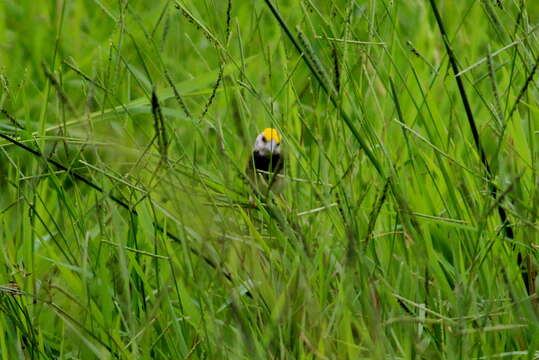Hidden Beauty - Black-breasted Weaver

Description:
Description: English: DID YOU KNOW! Scientific name: Ploceus benghalensis Higher classification: Ploceus Rank: Species Adult Brown crown and upper plumage Black pectoral band (not so full as in the breeding male) Prominent supercilium Ear spot Light yellow moustachial streaks Breeding Male Brilliant golden-yellow crown White throat Black band separates throat from fulvous-white underparts. Distribution Lowlands of Pakistan to peninsula India, Nepal and Bangladesh The Black-throated Weaver, also known as the Bengal Weaver or Black-breasted Weaver (Ploceus benghalensis), is a weaver resident in the northern river plains of the Indian subcontinent. Local Names: Hindi: Sarbo baya, Bengali: Shor baJa, Kantawala baya. Like the other weavers, the males build an enclosed nest from reeds and mud, and visiting females select a mate at least partially based on the quality of the nest. Distribution Resident or local migrant, endemic to South Asia. From NWFP to Indus Valley in Pakistan to the Gangetic Plains of northern India, to Assam and the Northeast and Bangladesh; commonly seen in the Himalayan terai; patchy to the south in Gujarat and Andhra Pradesh. Description •Size: Sparrow (ca. 15 cm) •Appearance: Male in breeding plumage has brilliant golden-yellow crown, white throat and a black band separating it from the fulvous-white underparts. In non-breeding male and female, crown brown like rest of upper plumage; black pectoral band less developed. A prominent supercilium, a spot behind ear, and narrow moustachial streaks, pale yellow. Flocks about cultivation and around reedy margins of tanks and jheels (shallow lakes), or extensive tall grass areas. •Behaviour: Polygynous; colonial; on the whole similar to those of the Baya and Streaked Weavers. •Courtship: Male constructs the nest single-handedly, with a group of females visiting it during late construction stage, jumping on the helmets and tugging and testing, presumably for strength. If a female appears interested, the male bows low before her, presenting golden crown at her. Flaps wings deliberately and sings softly tsi-tsisik-tsisik-tsik-tsik like chirp of cricket or subdued squeaking of unoiled bicycle wheel. Once female agrees and permits copulation, he quickly finishes the rest of the nest, and she lays eggs inside; he immediately commences on a second nest nearby to attract other females, and occasionally a third, very rarely even a fourth. Nests not accepted by females may be torn down by the builder himself. Date: 16 August 2016, 15:48:34. Source: Own work. Author: Shiv's fotografia.
Included On The Following Pages:
- Life (creatures)
- Cellular (cellular organisms)
- Eukaryota (eukaryotes)
- Opisthokonta (opisthokonts)
- Metazoa (Animal)
- Bilateria
- Deuterostomia (deuterostomes)
- Chordata (Chordates)
- Vertebrata (vertebrates)
- Gnathostomata (jawed fish)
- Osteichthyes
- Sarcopterygii (Lobe-finned fishes)
- Tetrapoda (terrestrial vertebrates)
- Amniota (amniotes)
- Reptilia (Reptiles)
- Diapsida (diapsid)
- Archosauromorpha (archosauromorph)
- Archosauria (Archosaurs)
- Dinosauria (dinosaurs and birds)
- Saurischia
- Theropoda (theropods)
- Tetanurae (tetanuran theropod)
- Coelurosauria (coelurosaur)
- Maniraptoriformes
- Maniraptora (maniraptoran)
- Aves (birds)
- Ornithurae
- Neornithes
- Neognathae (Neognaths)
- Neoaves
- landbirds
- Passeriformes (perching birds)
- Oscines
- Passeroidea
- Ploceidae (weavers and relatives)
- Ploceus
- Ploceus benghalensis (Black-breasted Weaver)
This image is not featured in any collections.
Source Information
- license
- cc-by-sa-3.0
- copyright
- Shiv's fotografia
- creator
- Shiv's fotografia
- original
- original media file
- visit source
- partner site
- Wikimedia Commons
- ID


